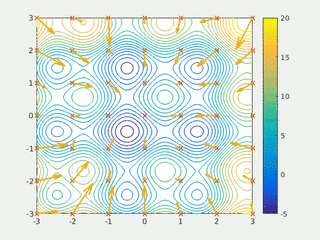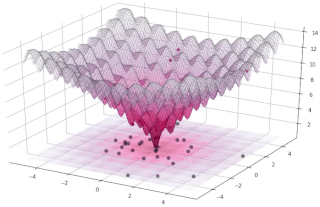Related Research Articles

In computer science and operations research, a genetic algorithm (GA) is a metaheuristic inspired by the process of natural selection that belongs to the larger class of evolutionary algorithms (EA). Genetic algorithms are commonly used to generate high-quality solutions to optimization and search problems by relying on biologically inspired operators such as mutation, crossover and selection. John Holland introduced genetic algorithms in 1960 based on the concept of Darwin’s theory of evolution, and his student David E. Goldberg further extended GA in 1989.

Mathematical optimization or mathematical programming is the selection of a best element from some set of available alternatives. Optimization problems of sorts arise in all quantitative disciplines from computer science and engineering to operations research and economics, and the development of solution methods has been of interest in mathematics for centuries.

A greedy algorithm is any algorithm that follows the problem-solving heuristic of making the locally optimal choice at each stage. In many problems, a greedy strategy does not usually produce an optimal solution, but nonetheless a greedy heuristic may yield locally optimal solutions that approximate a globally optimal solution in a reasonable amount of time.

In computer science, evolutionary computation is a family of algorithms for global optimization inspired by biological evolution, and the subfield of artificial intelligence and soft computing studying these algorithms. In technical terms, they are a family of population-based trial and error problem solvers with a metaheuristic or stochastic optimization character.

In computational science, particle swarm optimization (PSO) is a computational method that optimizes a problem by iteratively trying to improve a candidate solution with regard to a given measure of quality. It solves a problem by having a population of candidate solutions, here dubbed particles, and moving these particles around in the search-space according to simple mathematical formulae over the particle's position and velocity. Each particle's movement is influenced by its local best known position, but is also guided toward the best known positions in the search-space, which are updated as better positions are found by other particles. This is expected to move the swarm toward the best solutions.
The greedy randomized adaptive search procedure is a metaheuristic algorithm commonly applied to combinatorial optimization problems. GRASP typically consists of iterations made up from successive constructions of a greedy randomized solution and subsequent iterative improvements of it through a local search. The greedy randomized solutions are generated by adding elements to the problem's solution set from a list of elements ranked by a greedy function according to the quality of the solution they will achieve. To obtain variability in the candidate set of greedy solutions, well-ranked candidate elements are often placed in a restricted candidate list (RCL), and chosen at random when building up the solution. This kind of greedy randomized construction method is also known as a semi-greedy heuristic, first described in Hart and Shogan (1987).

In evolutionary computation, differential evolution (DE) is a method that optimizes a problem by iteratively trying to improve a candidate solution with regard to a given measure of quality. Such methods are commonly known as metaheuristics as they make few or no assumptions about the problem being optimized and can search very large spaces of candidate solutions. However, metaheuristics such as DE do not guarantee an optimal solution is ever found.
Extremal optimization (EO) is an optimization heuristic inspired by the Bak–Sneppen model of self-organized criticality from the field of statistical physics. This heuristic was designed initially to address combinatorial optimization problems such as the travelling salesman problem and spin glasses, although the technique has been demonstrated to function in optimization domains.
Sequential quadratic programming (SQP) is an iterative method for constrained nonlinear optimization. SQP methods are used on mathematical problems for which the objective function and the constraints are twice continuously differentiable.
Multi-objective optimization is an area of multiple criteria decision making that is concerned with mathematical optimization problems involving more than one objective function to be optimized simultaneously. Multi-objective optimization has been applied in many fields of science, including engineering, economics and logistics where optimal decisions need to be taken in the presence of trade-offs between two or more conflicting objectives. Minimizing cost while maximizing comfort while buying a car, and maximizing performance whilst minimizing fuel consumption and emission of pollutants of a vehicle are examples of multi-objective optimization problems involving two and three objectives, respectively. In practical problems, there can be more than three objectives.
ECJ is a freeware evolutionary computation research system written in Java. It is a framework that supports a variety of evolutionary computation techniques, such as genetic algorithms, genetic programming, evolution strategies, coevolution, particle swarm optimization, and differential evolution. The framework models iterative evolutionary processes using a series of pipelines arranged to connect one or more subpopulations of individuals with selection, breeding (such as crossover, and mutation operators that produce new individuals. The framework is open source and is distributed under the Academic Free License. ECJ was created by Sean Luke, a computer science professor at George Mason University, and is maintained by Sean Luke and a variety of contributors.
Parallel metaheuristic is a class of techniques that are capable of reducing both the numerical effort and the run time of a metaheuristic. To this end, concepts and technologies from the field of parallelism in computer science are used to enhance and even completely modify the behavior of existing metaheuristics. Just as it exists a long list of metaheuristics like evolutionary algorithms, particle swarm, ant colony optimization, simulated annealing, etc. it also exists a large set of different techniques strongly or loosely based in these ones, whose behavior encompasses the multiple parallel execution of algorithm components that cooperate in some way to solve a problem on a given parallel hardware platform.
A hyper-heuristic is a heuristic search method that seeks to automate, often by the incorporation of machine learning techniques, the process of selecting, combining, generating or adapting several simpler heuristics to efficiently solve computational search problems. One of the motivations for studying hyper-heuristics is to build systems which can handle classes of problems rather than solving just one problem.
Dantzig–Wolfe decomposition is an algorithm for solving linear programming problems with special structure. It was originally developed by George Dantzig and Philip Wolfe and initially published in 1960. Many texts on linear programming have sections dedicated to discussing this decomposition algorithm.
Cooperative Coevolution (CC) is an evolutionary computation method that divides a large problem into subcomponents and solves them independently in order to solve the large problem.
In applied mathematics, multimodal optimization deals with optimization tasks that involve finding all or most of the multiple solutions of a problem, as opposed to a single best solution. Evolutionary multimodal optimization is a branch of evolutionary computation, which is closely related to machine learning. Wong provides a short survey, wherein the chapter of Shir and the book of Preuss cover the topic in more detail.
MINOS is a Fortran software package for solving linear and nonlinear mathematical optimization problems. MINOS may be used for linear programming, quadratic programming, and more general objective functions and constraints, and for finding a feasible point for a set of linear or nonlinear equalities and inequalities.
In mathematics and computer science, an algorithmic technique is a general approach for implementing a process or computation.
References
- ↑ T.A. Feo and M.G.C. Resende (1989) "A probabilistic heuristic for a computationally difficult set covering problem". Operations Research Letters, 8:67–71, 1989.
- ↑ T.A. Feo and M.G.C. Resende (1995) "Greedy randomized adaptive search procedures". Journal of Global Optimization, 6:109–133, 1995.
- ↑ M. A. Potter and K. A. D. Jong, "A cooperative coevolutionary approach to function optimization", in PPSN III: Proceedings of the International Conference on Evolutionary Computation. The Third Conference on Parallel Problem Solving from Nature London, UK:Springer-Verlag, 1994, pp. 249–257.
- 1 2 3 4 Glorieux E., Danielsson F., Svensson B., Lennartson B., "Optimisation of interacting production stations using a Constructive Cooperative Coevolutionary approach", 2014 IEEE International Conference on Automation Science and Engineering (CASE), pp.322-327, August 2014, Taipei, Taiwan
- 1 2 3 Glorieux E., Svensson B., Danielsson F., Lennartson B., "A Constructive Cooperative Coevolutionary Algorithm Applied to Press Line Optimisation", Proceedings of the 24th International Conference on Flexible Automation and Intelligent Manufacturing (FAIM), pp.909-917, May 2014, San Antonio, Texas, USA
- 1 2 Glorieux E., Svensson B., Danielsson F., Lennartson B.: "Constructive cooperative coevolution for large-scale global optimisation", Journal of Heuristics, 2017.
- ↑ Glorieux E., Danielsson F., Svensson B., Lennartson B.: "Constructive cooperative coevolutionary optimisation for interacting production stations", International Journal of Advanced Manufacturing Technology, 2015.
- ↑ Glorieux E., Svensson B., Danielsson F., Lennartson B., "Improved Constructive Cooperative Coevolutionary Differential Evolution for Large-Scale Optimisation", 2015 IEEE Symposium Series on Computational Intelligence, December 2015
- 1 2 Glorieux E., Svensson B., Danielsson F., Lennartson B., "Multi-objective constructive cooperative coevolutionary optimization of robotic press-line tending", Engineering Optimization, Vol. 49, Iss. 10, 2017, pp 1685-1703
- ↑ Storn, Rainer, and Kenneth Price. "Differential evolution–a simple and efficient heuristic for global optimization over continuous spaces", Journal of global optimization 11.4 (1997): 341-359.
- ↑ Eberhart, Russ C., and James Kennedy. "A new optimizer using particle swarm theory", Proceedings of the sixth international symposium on micro machine and human science. Vol. 1. 1995.